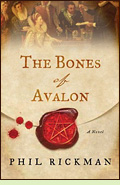|
The Bones of Avalonby Phil RickmanReviewed by Margaret Donsbach In 1650, three years into Elizabeth's reign, she is still a young and inexperienced queen, her throne not yet secure. Repeated shifts between Catholicism and Protestantism have divided the country, sowing resentment, secrecy and suspicion. Cheap printed flyers spread frightening occult predictions; some infuriate John Dee by invoking him as their author. In this unsettled climate, the novel has Elizabeth's adviser William Cecil sending Dee and Elizabeth's favorite Robert Dudley on a mission to discover what became of the bones of King Arthur after their resting place, Glastonbury Abbey, was dissolved and its buildings partially dismantled in Henry VIII's reign. In Glastonbury, once the mystical Isle of Avalon, Dee discovers that the official Protestant religion is being challenged not only by secret Catholics but by people still following practices and beliefs of pre-Christian times. When the body of Dudley's trusted servant is found gruesomely mutilated within the Abbey's ruins, their mission, already politically risky, turns into a murder investigation that may threaten not only their reputations but their lives. The novel offers an interesting portrait of a John Dee who cares deeply about scientific rigor, deplores sensationalism, and yet longs for a genuine psychic experience. Another well drawn character is a woman whose work straddles the border between the ancient healing arts and the "modern." The story can be slow-moving at times, with extended passages detailing Dee's thought processes, but readers interested in the Renaissance approach to science and the occult will find The Bones of Avalon an authentic, insightful portrayal of the period. (2010; 440 pages, including Notes and Credits discussing sources and some of the history behind the story) More about The Bones of Avalon at Powell's Books or Amazon.com
The Divine Sacrifice by Tony Hays (2010), about an adviser to King Arthur who must investigate a case of murder during a meeting at Glastonbury Abbey. More info Grave Goods by Ariana Franklin (2009), about a Sicilian woman physician in the time of Henry II who investigates the bones rumored to be those of King Arthur and Queen Guinevere. See review or more info at Powell's Books The Brothers of Glastonbury by Kate Sedley (1997), about a former monk at Glastonbury Abbey who investigates what happened to a groom from Glastonbury who disappeared just before the wedding. More info
The Queen's Conjurer by Benjamin Woolley (2001), recommended by Phil Rickman as "most recent and best." More info John Dee: The World of an Elizabethan Magus by Peter J. French (1980). More info John Dee: Scientist, Geographer, Astrologer and Secret Agent to Elizabeth I by Richard Deacon (1968). More info
Back to Novels of the Renaissance
|
